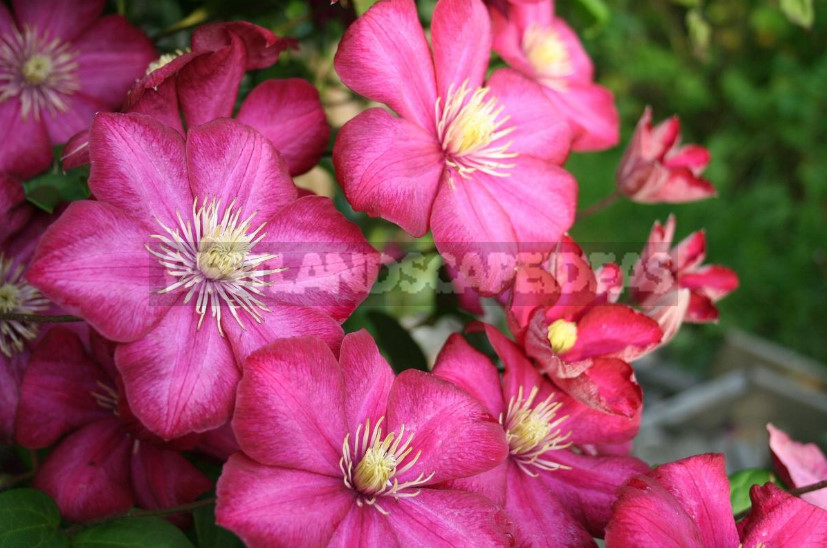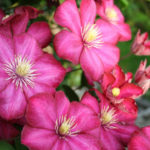Writing about clematis modern authors with good reason, though corny, call it “a true masterpiece among the climbing”, “king of the climbing”, “star among the vines” , etc.
Introduction to clematis
So, clematis, it is mainly climbing plant, rising up with leaf stalks, which in contact with the support quickly bend, break and cover it. In addition, the stem has a mustache, fixed on the support (hence, in fact, is its scientific name, given by another Dioscoride, from the ancient Greek clema – mustache).
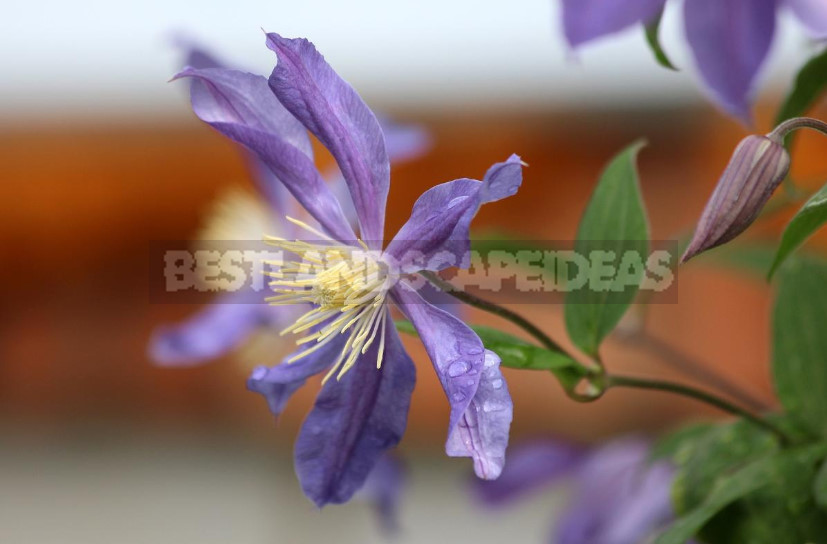
In flowers (more precisely, perianth) clematis no petals, their role is performed by colored sepals. But the petals of the Atragene is, the structure of the flower is different, so botanists consider that it is a different kind of practice although this fact is hard to ignore. Flowers differ in a variety of colors, shapes and sizes. The colors range from pure white to dark purple, including pink, red, purple, blue, blue and so on. There are clematis with very dark — almost black — velvety flowers.
In the description of varieties indicate the color of sepals at the beginning of flowering, over time it may vary slightly. As flowering plants are covered with silver fruit, decorated with silky curly tassels.
Clematis as a garden flower
Under this name in 1872 in France there was a book of famous breeders T. Moret and J. Jackmanii. It clematis likened valuable, but not yet developed ore. And now about 300 of its natural species are known, more than 2000 varieties and forms are derived. A good hundred of them can be purchased in our market.
For the first time the classification of clematis was proposed in 1872. For practical use, numerous species and varieties of clematis were divided into curly and non-curly (Bush), and they in turn were divided into small-flowered and large-flowered.
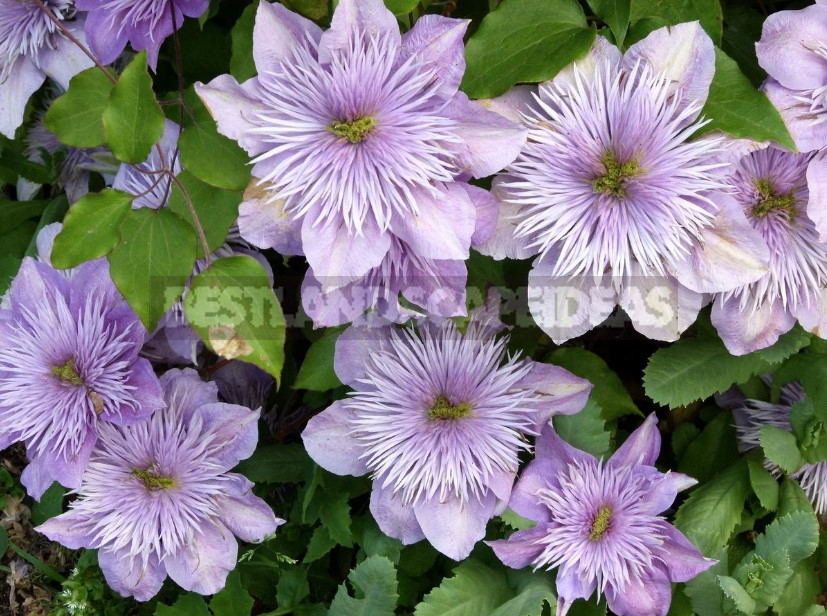
By large-flowered climbing clematis include varieties and hybrid forms of groups Viticella, Jackmanii, Lanuginose, Patents and others. To large-sectional – varieties and hybrids macadamia integrifolia group. From small and they grow medium-blossom clematis known group Atragene, Hexapetala, Heracleifolia, Montana and others.
The most spectacular – large-flowered varieties reaching 25 cm in diameter, especially luxurious look Terry. Recently, greatly increased interest in small-flower varieties. They are light, airy, characterized by particularly abundant flowering, undemanding to growing conditions and extremely frost-resistant. In addition, they are easier to combine in the garden with other plants, while large-flowered forms are especially good in the role of soloists.
Clematis in garden design
The choice is so great that with the help of clematis alone you can decorate the wall of the house, a gazebo or a fence, create a colorful screen or a border, break a flower bed. They are good for both single and group landings. Clematis in containers can be used for planting of balconies and loggias. In addition, these flowers are perfectly preserved in the cut and can be used for bouquets and exquisite floral arrangements. Some species can be used as ground cover plants (in particular, on the slopes).

See, for example, how John Brooks actively uses clematis. It covers the wall with a carpet of large-flowered clematis (‘Lazurstern’, ‘Ville de Lyon’), vines and Golden hops; clematis mountain lets on the walls and trunks of fruit trees; in the Sunny, dry, wall-protected border plants clematis, and silver leaves of mullein and gold birch creates a contrast; introduces into the curb low grassy species, and early and late-flowering clematis puts in a pair climbing roses. However, the most suitable pair of clematis, as everyone who visited the garden at A. Marchenko, is the maiden grapes.
Atragene flowers smaller, but as abundant and as early — in may — they bloom. And in August-September can bloom again. Care Atragene minimum, grow like weeds — no trim or cover is not necessary. They make a lovely, but strong growth in some weird fences.
Species clematis look spectacular between Phlox, peonies, undersized shrubs. Beautiful combination of purple-purple clematis with yellow-orange daylilies — those and others bloom at the same time and for a long time. Natural landscapes can be created using Clematis alpina, blooming in may-June with blue-white flowers, and Tangut clematis, blooming in June-July with Golden-yellow flowers. They as a curtain will cover big groups of stones or coniferous trees.
Growing and caring for clematis
To clematis showed all its advantages, give the vines enough sun (6-8 hours a day), and the roots — freshness and moisture, thoroughly mulching the soil and shading the base of the Bush Aquilegia, geranium or cuff. Take care of fertile, loose, drained and alkaline soil. Find it a cozy, closed from the winds place, and deliver a reliable support.
Conveniently, when planting curly clematis is a small area. At the same time, their long shoots, densely covered with leaves and flowers, provide protection from the sun in large areas, create a special decorative effect. The support under the clematis must be reliable and strong. Depending on its shape, you can get blooming columns, arches, trellises.

To properly care for clematis, cut and cover for the winter, you need to know the features of its development, to which group it belongs.
- Group I
Atragene and some small-flowered clematis blooming in early spring do not require pruning. They bloom on the shoots of the previous year — therefore, they must be preserved; often they are not even removed from the supports and do not hide.
- Group II
Clematis groups C. patents, C. florida, C. lanuginose, blooming in early summer on last year’s shoots and — under favorable conditions — again in July and August on the shoots of the current year, cut in the fall, leaving 10-15 knots (1.2-1.5 m), turn into a ring and cover for the winter. Weak and dead shoots are removed completely.
- Group III
Clematis, flowering shoots of the current year: group C. jackmanii, C. viticella, C. integrifolia and herbaceous, whose shoots die at the end of the growing season – cut in the autumn to the base or to the first present sheet.
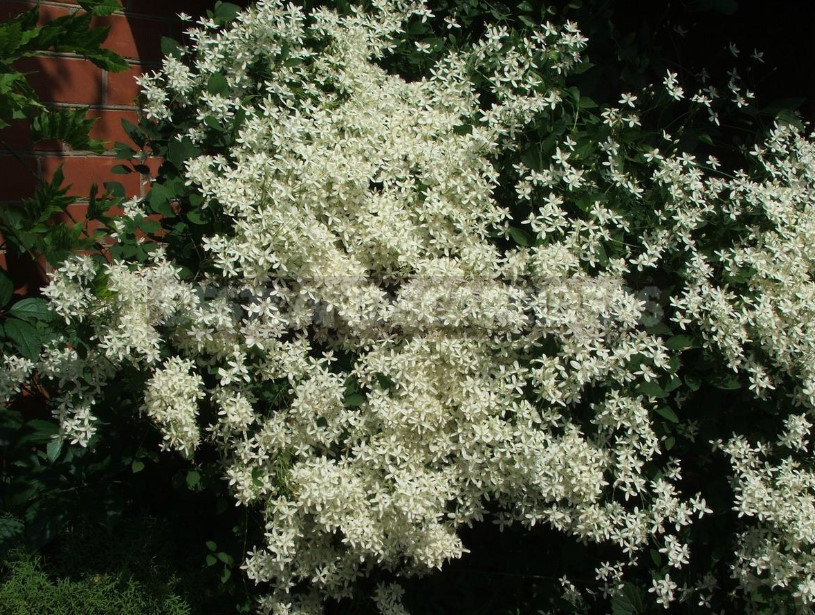
If the species and variety are unknown, cover the plant type II group, and in the spring watch where the flowering shoots will grow.
